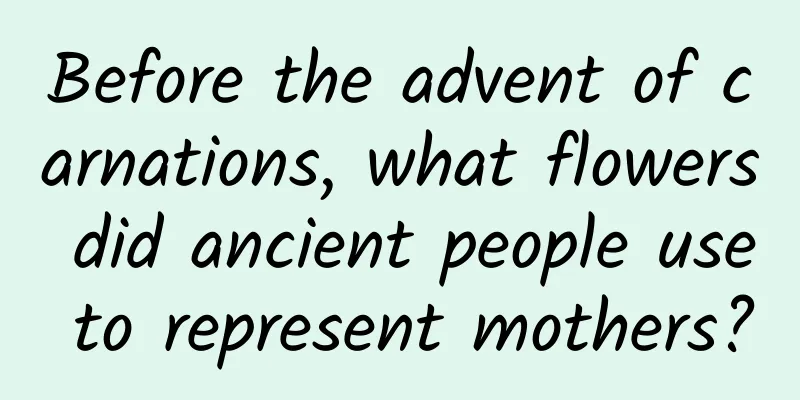Before the advent of carnations, what flowers did ancient people use to represent mothers?

|
Last December, I went to Suzhou with a friend. When visiting the Suzhou Fan Museum, my friend saw a painting and thought it was an orchid, but it didn't look as elegant as an orchid, so she asked me what kind of plant it was. I took a quick look and told her very seriously, "It's a daylily." Of course, although it is an ink painting, the bright orange-yellow flowers on the fan are still bright, indicating that it is the theme plant that literati and poets from ancient times to the present have loved - Hemerocallis Fulva. Daylilies are a common subject in traditional Chinese painting. They have orchid-like leaves and bright flowers. They often appear with longevity stones, implying "longevity and good fortune, and many sons and many years of life." This fan was taken at the Suzhou Fan Museum. Image: Bai Miao "Lily of the Day" Hemerocallis is a perennial herb with genus name composed of hemeros (daytime) and kallis (beautiful), indicating that the flowering period is very short and it only blooms during the day. The specific epithet Fulva means yellow hue, and the flower shape resembles lily, hence the name Day lily, which means "one-day lily". Daylily leaves resemble orchids and flowers resemble lilies. Image: Bai Miao Daylilies are found all over China and are a legitimate native species. I have seen large tracts of wild daylilies in the woods when I went hiking. Although daylilies do have orchid-like leaves when they are not in bloom, they are light and swaying, but if you look closely you will find the difference. Of course, if you dig up its roots, you will find that the swollen spindle roots underneath are even more prominent, which is completely different from orchids. Hemerocallis has enlarged spindle roots to accumulate nutrients and water, which makes it very resistant to barrenness and drought, and is therefore one of the top choices for domestic greening plants. Image: Bai Miao From "husband" to "mother" From the time of the Book of Songs to the Tang Dynasty, "forgetting worries" has always been one of the main images of daylilies. The famous line in the Book of Songs, Wei Feng, Bo Xi, "Where can I get the daylily? I said it was on the back of the tree. I wish I could say that I miss my husband, which makes my heart ache", is about a woman who misses her husband who is away on the battlefield and wants to plant grass in the north hall to make her forget her worries. In the Tang Dynasty, Lu Deming's Classic Interpretation of Classics explained daylily, saying: "It was originally written as Xuan. "Shuowen" wrote it as 藼. It is said that it makes people forget worries. Or it can be written as 蕿." "藼" and "蕿" are both variant forms of "萱", and daylily is daylily. The meaning of the word "谖" is to forget, and literally speaking, "谖草" is forget grass. Although the flowers of daylily are tiny, they stand out from the crowd. Among the chaotic leaves, each one is a fragrant heart. "This poem "Daylily" by Su Shi vividly depicts the shape of daylily. Image: Bai Miao Ji Kang of the Western Jin Dynasty wrote in his book “Health Preservation”: “Albizzia julibrissin relieves anger, while daylily relieves worries.” These two plants, which were originally completely unrelated, were linked together because they can both treat emotional distress and make people “happy and worry-free.” With the spread of poems such as “I miss you like daylily, and I forget my worries as soon as I see you” and “Du Kang can relieve boredom, and daylily relieves worries,” “forget-me-not” has gradually become a synonym for daylily. Daylilies were originally used to express longing for the husband. Since the Tang Dynasty, when Bian Rong wrote "Sending Xu Hao", daylilies were associated with mothers. "Knowing that you are leaving, your love is too strong. The cypress and chrysanthemums in the hall are covered with snow." "Chun" and "Xuan" are used together, with cypress representing the father and chrysanthemum representing the mother. Meng Jiao's "The Wanderer" has the following lines: "Daylilys grow on the steps of the hall, while the wanderer travels to the ends of the earth. The loving mother leans against the door of the hall, but no daylilies are seen." This directly evolved the meaning of "looking at the chrysanthemums and thinking of the husband" into the culture of "planting chrysanthemums to show filial piety to the mother". For your mother, would you choose carnations or daylilies? Image: Ulf Eliasson & カールおじさん/ wikimedia commons Later, poems such as "presenting daylilies to honor mothers" and "planting daylilies to celebrate birthdays" gradually became popular, making daylilies the "mother flower" in China. Nowadays, more people choose to give carnations to their mothers on Mother's Day, and they have long forgotten that the traditional mother flower in China is actually the seemingly ordinary daylily. In addition to the green belt, there is also a dining table at home The most common plant called daylily is not only the daylily Hemerocallis Fulva in the green belt, but also the daylily Hemerocallis citrina, also known as lemon daylily, which is popular on the table. Because the ancients had a broader concept of daylily, the so-called edible daylily is daylily, commonly known as golden needle flower. Daylily has a long history of cultivation in China. Ji Han's "Yinan Huaxu" also said: "The land of Jingchu is called Lucong...Now the people in the east pick its flower buds and sell them as a product, which is called daylily." The part we eat is the bud that is about to open. Daylily. Image: citron / wikimedia commons Day lilies are mostly sold as dried goods in the market, because they need to be soaked before they can be used in dishes. Image: Bai Miao Most of the daylilies sold on the market are dried flower buds, which can be used for cooking after being soaked and expanded. However, in recent years, poisoning incidents caused by eating fresh daylilies are not uncommon. Fresh daylilies contain a high content of colchicine, which can easily cause food poisoning if not cooked properly. Colchicine itself is less toxic, but it will be metabolized into dicolchicine, which is extremely toxic, in the body. Daylily buds. Photo: Amada44 / wikimedia commons However, colchicine is water-soluble, so fresh daylilies need to be processed. I am also a fan of fresh daylilies, so I always blanch them in boiling water to maximize the dissolution of colchicine in water, and then soak and wash them in clean water to ensure safe consumption. Of course, daylily contains colchicine, and daylily is no exception. Since different varieties of daylily contain different colchicine content, it is not reliable to distinguish whether it is safe to eat based solely on color. Not just "colorful daylily" Many natural daylily species bloom in the morning and wither in the evening, with a flowering period of only one day. This type of species that blooms in the morning and closes at night is called the day-blooming type. However, some species bloom in the afternoon or evening and do not wither until the next morning or even the next afternoon. This type is called the night-blooming type, such as the variety "Veins of truth", which blooms in the afternoon and withers before noon the next day. The daylilies we often eat are also of this type. The day-blooming daylily "Snow Line" has large white flowers up to 16cm in diameter, and the number of flowers per single flower is also outstanding. Image: Bai Miao Daylilies are very popular perennial plants abroad. With the development and utilization of horticultural varieties, daylilies are no longer limited to the common orange, orange-red, and yellow series. A large number of colors have been cultivated and entered the field of vision of enthusiasts. In Europe and the United States, new varieties of daylilies with excellent quality usually sell for one or two hundred US dollars. In addition, there will be breakthrough new varieties every few years, so if it is a particularly outstanding variety, it can be hyped up to thousands of US dollars. After that, it will gradually decline year by year, and finally slowly fall back to the price of ordinary goods. Breeding has resulted in some special flower shapes. The spider-shaped daylilies are slender and large, which is very different from the regular varieties with round petals. Image: Bai Miao However, daylilies are still not popular enough in the eyes of the general public in China. In addition, the large number of daylilies, "golden baby" daylilies and "red luck" daylilies planted in green belts has led to the fact that when it is mentioned, many people still have the intuitive feeling that it is "colorful daylily". Hybrid breeding has made the variations of daylilies more and more diverse. If you get to know them carefully, you will find that their cultural stories and breeding history are far from as simple as "colored daylilies". As a senior gardening enthusiast, I can talk to you for three days and three nights about the varieties of daylilies. When you pass by the roadside and see the daylilies planted in the green belt, you may sigh that such an ordinary little plant can also have such rich experiences. If a newbie doesn't know what to plant, then choose a daylily. In my opinion, it is a completely zero-difficulty plant. When it blooms, you can cut it and give it to your mother, pretending to be an intellectual who understands traditional culture. The large-flowered daylilies planted in my garden have hardly received any special care, but they bloom vigorously every year, and the number of flowers on the plants can easily reach 70-90 in early summer. Image: Bai Miao This article is the 115th article in the 6th year of the Species Calendar, and comes from the author of the Species Calendar @柏妙. |
>>: Understand futures first, then you will know how Bank of China lost money!
Recommend
How to apply for a Baidu promotion account and register a Baidu promotion demo account?
Baidu promotion does not have a simulated account...
Yuyue Medical's triple "dilemma"
Recently, the price of a blood oximeter made by Y...
New ways to play Douyin live broadcast in the food industry in 2022
In recent years, the number of Douyin users has c...
Do we have to be better ourselves? Perfectionism is not "perfect"...
In daily life, perfectionism is often seen as a p...
Blizzard + strong wind + cold wave multiple warnings are issued! Please pay attention to travel safety in low temperature, rain and snow weather →
At 06:00 on March 2, the Central Meteorological O...
Stop blindly comparing. This article teaches you how to judge whether your baby's height and weight meet the standards.
Author: Hu Fang, deputy chief physician, Women an...
Your character determines your upper limit: Let’s talk about the self-cultivation of operators
Today is the day of the college entrance examinat...
Typhoon Tali is about to land! How should we defend and respond?
At present, this year's No. 4 typhoon "T...
13 billion liters of water disappeared? Freshwater lake suddenly turned into saltwater lake? What happened?
At the end of the last century, Lake Pinnell in L...
The fresher the food, the better? These foods are not good if they are too fresh!
This issue is planned: 91, Little Dandelion This ...
Even if humans make mistakes, AI Agent can learn quickly!
To teach AI agents new skills, such as opening a ...
Does anesthesia affect the brain?
《Cotton Swab Medical Science Popularization》 Depa...
Interview with Jim Zemlin, Executive Director of the Linux Foundation: Open source has gone from being a niche genre to being known to everyone
The LC3 (LinuxCon + ContainerCon + CloudOpen) con...
Are those extremely low-level information flow ads really effective?
The online game advertisement mentioned by the to...
Samsung vs. Google: Who wins?
The American technology blog TheVerge published a...









